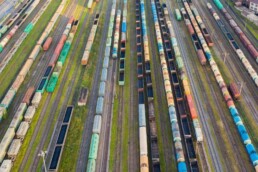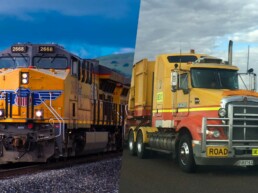Rail vs. Road Transportation: Key Differences for Efficient Shipping
Rail and road transportation stand as titans in the logistics realm, each offering unique advantages for shipping goods. When seeking efficiency and cost-effectiveness, deciphering between these two modes becomes pivotal. Let’s take a drive into the intricacies of rail vs. road transportation to unravel the optimal choice for your shipping needs.

Rail Transport: Unveiling the Dynamics
Rail transport, inherently reliant on dedicated tracks, emerges as a resilient mode for long-distance shipping. Additionally, it relies on specialized freight trains, strategically engineered to efficiently transport significant cargo volumes across extensive networks that stretch across continents and nations.
Advantages of Rail Transport:
1. Economies of Scale:
Freight trains capitalize on economies of scale, leveraging their ability to carry enormous loads per trip. This scalability translates into a cost advantage, particularly for long-haul shipments.
2. Environmental Sustainability:
Embracing rail transport contributes to environmental conservation. Its reduced carbon footprint per ton-mile compared to road transport aligns with eco-friendly logistics solutions.
3. Reliability in Long-Hauls:
For time-insensitive shipments, rail excels in reliability, delivering cargo without being significantly affected by external factors that often impede road transport.
Road Transport: The Wheels of Localized Logistics
In contrast, road transport maneuvers goods using trucks, catering adeptly to localized logistics, especially for shorter distances within a country’s boundaries.
Advantages of Road Transport:
1. Door-to-Door Service:
A distinct edge for road transport lies in its capability to offer door-to-door service, providing flexibility and convenience that rail transport might lack.
2. Time-Sensitive Deliveries:
Trucks excel in ensuring timely deliveries, especially for time-sensitive cargo, thanks to their ability to navigate through shorter distances swiftly.
3. Flexibility in Schedules:
Unlike rail, road transport grants the flexibility to tailor schedules according to specific delivery requests, accommodating varying logistical needs.
Comprehensive Analysis of Key Differences
When comparing rail and road transportation, there are important differences to consider. These differences affect things like cost, distance covered, how long it takes to deliver goods, safety, flexibility, and how much can be transported. Understanding these differences is important for making smart choices about how to move things from one place to another. It helps in planning the best way to get things where they need to go, making sure it’s done efficiently and smoothly.
1. Cost Consideration:
Rail transportation triumphs in cost-effectiveness for long distances, leveraging its capacity and reduced fuel consumption.
Conversely, road transport’s cost efficiency shines on shorter routes, often with lower shipping charges and adaptable pricing structures.
2. Distances Covered:
Rail thrives on long-haul routes due to its ability to transport larger volumes across extensive networks.
Roads cater effectively to shorter distances and offer more direct routes with a door-to-door service.
3. Transit Time:
Road transport typically ensures quicker transit due to its agility and flexibility in navigating through various terrains.
Rail transport, while having longer transit times, provides predictability and reliability not hampered by external factors.
4. Safety Measures:
Road transport is more susceptible to accidents due to factors like traffic congestion, weather conditions, and human errors.
Rail transport, with fewer accidents, boasts enhanced cargo safety through fewer handling instances.
5. Flexibility and Customization:
Roads grant flexibility in scheduling and customizing routes to meet specific delivery demands.
Rail operates on stringent preplanned schedules, limiting customization but ensuring adherence to timelines.
6. Capacity and Coverage:
Trucks have significant weight-bearing capacities, but rail haulage triumphs with its capability to move substantial cargo volumes in a single trip.
Rail networks have limitations in coverage compared to roads, necessitating intermodal transportation for comprehensive door-to-door service.
Beginner’s Guide to Third-Party Logistics (3PL)
The world of e-commerce is always changing, understanding the roll of Third-Party Logistics is integral to keeping up. This beginner’s guide to third-party logistics (3PL) will delve into the essential aspects, offering insights into fulfillment services, warehousing, and much more.
Read More…
Deciding the Optimal Choice
In navigating the labyrinth of logistics, the choice between rail and road transportation hinges upon various factors such as cost, timeframe, cargo volume, destination, and specific requirements.
Understanding the nuances between these two modes empowers informed decision-making, enabling businesses to tailor their transportation strategies for optimal efficiency, cost-effectiveness, and timely deliveries.





